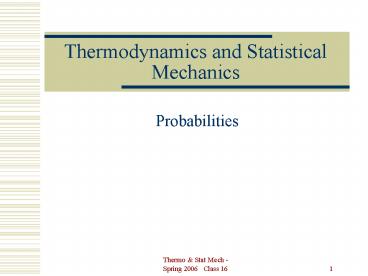Thermodynamics and Statistical Mechanics - PowerPoint PPT Presentation
1 / 33
Title:
Thermodynamics and Statistical Mechanics
Description:
Thermodynamics and Statistical Mechanics Probabilities Pair of Dice For one die, the probability of any face coming up is the same, 1/6. Therefore, it is equally ... – PowerPoint PPT presentation
Number of Views:59
Avg rating:3.0/5.0
Title: Thermodynamics and Statistical Mechanics
1
Thermodynamics and Statistical Mechanics
- Probabilities
2
Pair of Dice
- For one die, the probability of any face coming
up is the same, 1/6. Therefore, it is equally
probable that any number from one to six will
come up. - For two dice, what is the probability that the
total will come up 2, 3, 4, etc up to 12?
3
Probability
- To calculate the probability of a particular
outcome, count the number of all possible
results. Then count the number that give the
desired outcome. The probability of the desired
outcome is equal to the number that gives the
desired outcome divided by the total number of
outcomes. Hence, 1/6 for one die.
4
Pair of Dice
- List all possible outcomes (36) for a pair of
dice. - Total Combinations How Many
- 2 11 1
- 3 12, 21 2
- 4 13, 31, 22 3
- 5 14, 41, 23, 32 4
- 6 15, 51, 24, 42, 33 5
5
Pair of Dice
- Total Combinations How Many
- 7 16, 61, 25, 52, 34, 43 6
- 8 26, 62, 35, 53, 44 5
- 9 36, 63, 45, 54 4
- 10 46, 64, 55 3
- 11 56, 65 2
- 12 66 1
- Sum 36
6
Probabilities for Two Dice
7
Probabilities for Two Dice
8
Microstates and Macrostates
- Each possible outcome is called a microstate.
- The combination of all microstates that give the
same number of spots is called a macrostate. - The macrostate that contains the most microstates
is the most probable to occur.
9
Combining Probabilities
- If a given outcome can be reached in two (or
more) mutually exclusive ways whose probabilities
are pA and pB, then the probability of that
outcome is pA pB. - This is the probability of having either A or B.
10
Combining Probabilities
- If a given outcome represents the combination of
two independent events, whose individual
probabilities are pA and pB, then the probability
of that outcome is pA pB. - This is the probability of having both A and B.
11
Example
- Paint two faces of a die red. When the die is
thrown, what is the probability of a red face
coming up?
12
Another Example
- Throw two normal dice. What is the probability of
two sixes coming up?
13
Complications
- p is the probability of success. (1/6 for one
die) - q is the probability of failure. (5/6 for one
die) - p q 1, or q 1 p
- When two dice are thrown, what is the probability
of getting only one six?
14
Complications
- Probability of the six on the first die and not
the second is - Probability of the six on the second die and not
the first is the same, so
15
Simplification
- Probability of no sixes coming up is
- The sum of all three probabilities is
- p(2) p(1) p(0) 1
16
Simplification
- p(2) p(1) p(0) 1
- p² 2pq q² 1
- (p q)² 1
- The exponent is the number of dice (or tries).
- Is this general?
17
Three Dice
- (p q)³ 1
- p³ 3p²q 3pq² q³ 1
- p(3) p(2) p(1) p(0) 1
- It works! It must be general!
- (p q)N 1
18
Binomial Distribution
- Probability of n successes in N attempts
- (p q)N 1
- where, q 1 p.
19
Thermodynamic Probability
- The term with all the factorials in the previous
equation is the number of microstates that will
lead to the particular macrostate. It is called
the thermodynamic probability, wn.
20
Microstates
- The total number of microstates is
For a very large number of particles
21
Mean of Binomial Distribution
22
Mean of Binomial Distribution
23
Standard Deviation (s)
24
Standard Deviation
25
Standard Deviation
26
For a Binomial Distribution
27
Coins
- Toss 6 coins. Probability of n heads
28
For Six Coins
29
For 100 Coins
30
For 1000 Coins
31
Multiple Outcomes
32
Stirlings Approximation
33
Number Expected
- Toss 6 coins N times. Probability of n heads
- Number of times n heads is expected is
- n N P(n)































